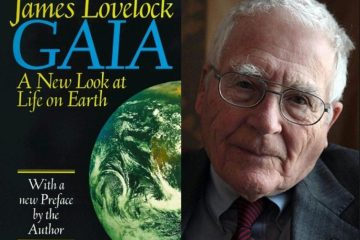In a world where the delicate balance of nature intertwines with the intricate web of life, one man dared to propose a groundbreaking theory that sparked a revolution in environmental thought. Enter James Lovelock and his Gaia Principle, a concept that transcends the traditional view of Earth as a mere planet and instead envisions it as a self-regulating organism. Join us on a journey to explore the depths of this captivating theory and unravel the mysteries of our interconnected world.
Table of Contents
- I. Understanding the Gaia Principle: James Lovelock’s Revolutionary Concept
- II. Gaia Theory in Practice: How Earth Functions as a Self-Regulating System
- III. Implications of the Gaia Hypothesis: Ecology, Climate Change, and Sustainability
- IV. Embracing Gaia’s Wisdom: Practical Applications and Future Considerations
- Q&A
- In Retrospect

I. Understanding the Gaia Principle: James Lovelock’s Revolutionary Concept
Exploring the Gaia Principle unveils a groundbreaking perspective on Earth as a self-regulating organism. James Lovelock’s visionary concept challenges traditional views and proposes that the planet functions as a single, living entity where biotic and abiotic factors interact synergistically.
**Key Points:**
- Interconnectedness of ecosystems
- Dynamic equilibrium
- Sustainability through feedback mechanisms
| Aspect | Summary |
|---|---|
| Balance | Earth’s ability to maintain stability through intricate processes |
| Adaptation | Resilience to changes for long-term survival |

II. Gaia Theory in Practice: How Earth Functions as a Self-Regulating System
In the intricate web of life, the Gaia theory unveils the profound interconnectedness of Earth’s ecosystems, painting a picture of our planet as a living, self-regulating organism. From the depths of the oceans to the vast stretches of land, nature operates in a delicate balance, adapting and responding to changes to maintain an equilibrium that sustains life. This holistic perspective, championed by James Lovelock, challenges us to see Earth not merely as a collection of separate entities, but as a unified whole where every component plays a vital role in the grand symphony of existence.
At the core of the Gaia principle lies the concept of feedback mechanisms, wherein Earth’s biophysical systems interact harmoniously to regulate conditions for optimal survival. Through intricate processes like the carbon cycle, ocean currents, and biodiversity, the planet showcases its remarkable ability to adjust and stabilize environmental factors. This dynamic dance of give-and-take underscores the resilience and intelligence inherent in nature’s design, showcasing Earth as a majestic living entity that pulsates with vitality and wisdom. With each sunrise and every whisper of the wind, Gaia whispers her secrets of interconnectedness and interdependence, inviting us to embrace a deeper understanding of our place within the cosmic tapestry.
III. Implications of the Gaia Hypothesis: Ecology, Climate Change, and Sustainability
Exploring the depths of the Gaia Hypothesis takes us on a journey through interconnectedness and harmony within the natural world. James Lovelock’s revolutionary concept challenges traditional views of Earth as a passive rock hurtling through space. Instead, it portrays our planet as a living, self-regulating organism, where all living and non-living entities interact to maintain stability and balance.
With a focus on ecology, the Gaia principle emphasizes the intricate web of relationships between species and their environment, highlighting the importance of preserving biodiversity. As we delve deeper into the implications of this hypothesis, we uncover profound insights into climate change mitigation and sustainable practices that could safeguard our planet for future generations. Embracing the Gaia Hypothesis opens up new horizons for environmental stewardship and a profound respect for the delicate interplay of life on Earth.

IV. Embracing Gaia’s Wisdom: Practical Applications and Future Considerations
Exploring the intricate concept of Gaia’s Wisdom through the lens of James Lovelock’s Gaia Principle opens up a realm of possibilities for practical applications and future considerations. It invites us to delve deeper into the interconnectedness of all living beings on Earth, highlighting the importance of nurturing and respecting our planet.
By embracing Gaia’s Wisdom, we uncover innovative ways to harmonize with nature, fostering sustainability and balance in our actions. This holistic approach encourages us to reevaluate our relationship with the environment and envision a future where humanity thrives in symbiosis with the Earth. Through conscious choices and mindful practices, we can honor Gaia’s Wisdom and contribute to a more sustainable and resilient world for generations to come.
Q&A
—
Q&A: Exploring the Fascinating Gaia Principle by James Lovelock
Q: What is the Gaia Principle proposed by James Lovelock?
A: The Gaia Principle, put forth by renowned scientist James Lovelock, suggests that Earth functions as a self-regulating organism where living organisms and their inorganic surroundings form a complex system that maintains the conditions necessary for life on the planet.
Q: How did James Lovelock come up with the concept of the Gaia Principle?
A: Inspired by the chemical composition of Mars and Venus, Lovelock, an atmospheric scientist, developed the Gaia hypothesis in the 1960s while working with NASA to detect life on Mars.
Q: What does the Gaia Principle imply for the relationship between Earth and living organisms?
A: According to the Gaia Principle, living organisms interact with the Earth’s surface and atmosphere to create a feedback system that helps regulate temperature, atmospheric composition, and other key environmental factors essential for life to thrive.
Q: How has the Gaia Principle influenced environmental thinking and sustainability practices?
A: Lovelock’s Gaia Principle has sparked discussions on the interconnectedness of all living organisms and the environment, promoting a holistic approach to environmental conservation and sustainability efforts worldwide.
Q: Are there critics of the Gaia Principle, and if so, what are their main arguments against it?
A: While the Gaia Principle has received both praise and criticism, some skeptics argue that it veers into a form of anthropomorphism, attributing human-like characteristics to the Earth as a whole, which they find scientifically unfounded.
Q: What implications does the Gaia Principle hold for future environmental policies and global climate action?
A: The Gaia Principle underscores the importance of viewing Earth as a dynamic, interconnected system that requires collective action and responsible stewardship to preserve and protect for future generations.
This Q&A offers a glimpse into the captivating world of the Gaia Principle proposed by James Lovelock, inviting readers to delve deeper into the interconnected web of life and the environment.
In Retrospect
As we delve into the intriguing concept of the Gaia Principle proposed by James Lovelock, we are reminded of the interconnectedness of our planet and the delicate balance that sustains life. Lovelock’s groundbreaking theory encourages us to view Earth as a self-regulating organism, urging us to reflect on our actions and their impact on this collective ecosystem. Embracing the Gaia Principle can inspire us to cultivate a deeper appreciation for the intricate web of life that surrounds us, fostering a sense of responsibility towards preserving the harmony of our planet for generations to come. Let us embark on this journey of understanding and reverence for the Earth, guided by the wisdom of James Lovelock’s visionary outlook on the interconnectedness of all living beings on this precious orb we call home.



0 Comments